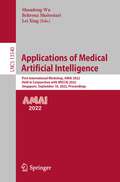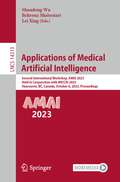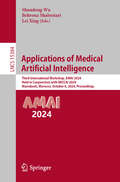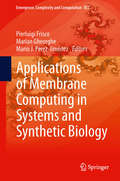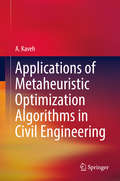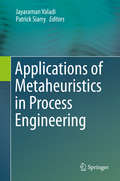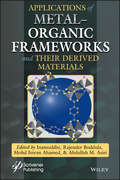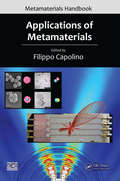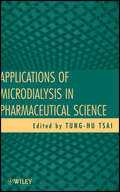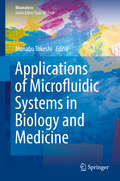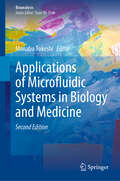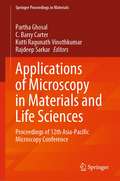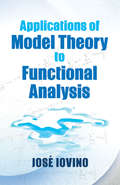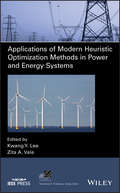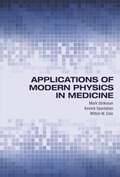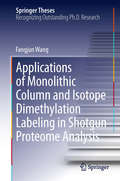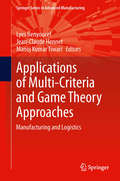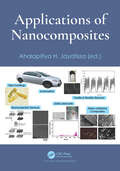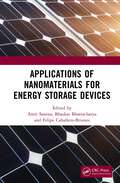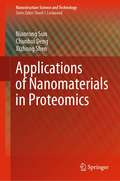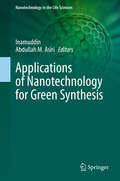- Table View
- List View
Applications of Medical Artificial Intelligence: First International Workshop, AMAI 2022, Held in Conjunction with MICCAI 2022, Singapore, September 18, 2022, Proceedings (Lecture Notes in Computer Science #13540)
by Shandong Wu Behrouz Shabestari Lei XingThis book constitutes the refereed proceedings of the first International Workshop on Applications of Medical Artificial Intelligence, AMAI 2022, held in conjunction with MICCAI 2022, in Singapore, in September 2022. The book includes 17 papers which were carefully reviewed and selected from 26 full-length submissions.Practical applications of medical AI bring in new challenges and opportunities. The AMAI workshop aims to engage medical AI practitioners and bring more application flavor in clinical, evaluation, human-AI collaboration, new technical strategy, trustfulness, etc., to augment the research and development on the application aspects of medical AI, on top of pure technical research.
Applications of Medical Artificial Intelligence: Second International Workshop, AMAI 2023, Held in Conjunction with MICCAI 2023, Vancouver, BC, Canada, October 8, 2023, Proceedings (Lecture Notes in Computer Science #14313)
by Shandong Wu Behrouz Shabestari Lei XingThis book constitutes the refereed proceedings of the first International Workshop on Applications of Medical Artificial Intelligence, AMAI 2023, held in conjunction with MICCAI 2023, in Vancouver, Canada in October 2023. The book includes 17 papers which were carefully reviewed and selected from 26 full-length submissions.The AMAI 2023 workshop created a forum to bring together researchers, clinicians, domain experts, AI practitioners, industry representatives, and students to investigate and discuss various challenges and opportunities related to applications of medical AI.
Applications of Medical Artificial Intelligence: Third International Workshop, AMAI 2024, Held in Conjunction with MICCAI 2024, Marrakesh, Morocco, October 6, 2024, Proceedings (Lecture Notes in Computer Science #15384)
by Shandong Wu Behrouz Shabestari Lei XingThis book constitutes the refereed proceedings of the Third International Workshop on Applications of Medical Artificial Intelligence, AMAI 2024, held in conjunction with MICCAI 2024, in Marrakesh, Morocco on October 6th, 2024. The volume includes 24 papers which were carefully reviewed and selected from 59 submissions. The AMAI 2024 workshop created a forum to bring together researchers, clinicians, domain experts, AI practitioners, industry representatives, and students to investigate and discuss various challenges and opportunities related to applications of medical AI.
Applications of Membrane Computing in Systems and Synthetic Biology (Emergence, Complexity and Computation #7)
by Pierluigi Frisco Marian Gheorghe Mario J. Pérez-JiménezMembrane Computing was introduced as a computational paradigm in Natural Computing. The models introduced, called Membrane (or P) Systems, provide a coherent platform to describe and study living cells as computational systems. Membrane Systems have been investigated for their computational aspects and employed to model problems in other fields, like: Computer Science, Linguistics, Biology, Economy, Computer Graphics, Robotics, etc. Their inherent parallelism, heterogeneity and intrinsic versatility allow them to model a broad range of processes and phenomena, being also an efficient means to solve and analyze problems in a novel way. Membrane Computing has been used to model biological systems, becoming with time a thorough modeling paradigm comparable, in its modeling and predicting capabilities, to more established models in this area. This book is the result of the need to collect, in an organic way, different facets of this paradigm. The chapters of this book, together with the web pages accompanying them, present different applications of Membrane Systems to Biology. Deterministic, non-deterministic and stochastic systems paired with different algorithms and methodologies show the full potential of this framework. The book is addressed to researchers interested in applications of discrete biological models and the interplay between Membrane Systems and other approaches to analyze complex systems.
Applications of Membrane Technology for Food Processing Industries
by M. SelvamuthukumaranMembranes processing techniques are used to help separate chemical components based on molecular size under specific pressure. A great advantage of membrane processing techniques is that it is a non-thermal processing technique, which can retain enormous bioactive constituents to a greater extent. Being a less energy intensive process, this technique is widely used in several food processing industries such as in the clarification of fruit juices and wine; the concentration of milk; the preparation of whey protein concentrate; and water and waste treatment, among others. Applications of Membrane Technology for Food Processing Industries introduces membrane processing techniques, presenting principles, theory and operational conditions for achieving efficient quality product. It discusses different types of membrane processing techniques viz. reverse osmosis, nanofiltration, ultrafiltration, electro dialysis, microfiltration, pervaporation, including its applications, advantages and disadvantages. Key Features: Deals with the retention of antioxidants by using novel membrane processing techniques Includes the application of membrane processing techniques in whey processing Explains the method for degumming, dewaxing and decolorization of edible crude oils Narrates application of membrane processing techniques in waste water treatment for efficient use Readers, such as professors, scientist, research scholars, students and industrial personnel, will come to know about the current trends in use of membrane processing techniques for its application in several food processing industries. This book can be a ready reference for the food industrial industry for manufacturing of deacidified clarified fruit juices and wine by using integrated membrane technique approach. In a nutshell, this book will benefit food scientist, academicians, students and food industrial persons by providing in-depth knowledge about membrane processing of foods for quality retention and also for efficient consumer acceptability.
Applications of Metaheuristic Optimization Algorithms in Civil Engineering
by A. KavehThe book presents recently developed efficient metaheuristic optimization algorithms and their applications for solving various optimization problems in civil engineering. The concepts can also be used for optimizing problems in mechanical and electrical engineering.
Applications of Metaheuristics in Process Engineering
by Patrick Siarry Jayaraman ValadiMetaheuristics exhibit desirable properties like simplicity, easy parallelizability and ready applicability to different types of optimization problems such as real parameter optimization, combinatorial optimization and mixed integer optimization. They are thus beginning to play a key role in different industrially important process engineering applications, among them the synthesis of heat and mass exchange equipment, synthesis of distillation columns and static and dynamic optimization of chemical and bioreactors. This book explains cutting-edge research techniques in related computational intelligence domains and their applications in real-world process engineering. It will be of interest to industrial practitioners and research academics.
Applications of Metal-Organic Frameworks and Their Derived Materials
by Rajender Boddula Inamuddin Mohd Imran Ahamed Abdullah M. AsiriMetal–organic frameworks (MOFs) are porous crystalline polymers constructed by metal sites and organic building blocks. Since the discovery of MOFs in the 1990s, they have received tremendous research attention for various applications due to their high surface area, controllable morphology, tunable chemical properties, and multifunctionalities, including MOFs as precursors and self-sacrificing templates for synthesizing metal oxides, heteroatom-doped carbons, metal-atoms encapsulated carbons, and others. Thus, awareness and knowledge about MOFs and their derived nanomaterials with conceptual understanding are essential for the advanced material community. This breakthrough new volume aims to explore down-to-earth applications in fields such as biomedical, environmental, energy, and electronics. This book provides an overview of the structural and fundamental properties, synthesis strategies, and versatile applications of MOFs and their derived nanomaterials. It gives an updated and comprehensive account of the research in the field of MOFs and their derived nanomaterials. Whether as a reference for industry professionals and nanotechnologists or for use in the classroom for graduate and postgraduate students, faculty members, and research and development specialists working in the area of inorganic chemistry, materials science, and chemical engineering, this is a must-have for any library.
Applications of Metamaterials (Metamaterials Handbook)
by Filippo CapolinoThis book uses the first volume’s exploration of theory, basic properties, and modeling topics to develop readers’ understanding of applications and devices that are based on artificial materials. It explores a wide range of applications in fields including electronics, telecommunications, sensing, medical instrumentation, and data storage. The text also includes a practical user’s guide and explores key areas in which artificial materials have developed. It includes experts’ perspectives on current and future applications of metamaterials, to present a well-rounded view on state-of-the-art technologies.
Applications of Microdialysis in Pharmaceutical Science
by Tung-Hu TsaiDiscover new and emerging applications for microdialysis in drug evaluationMicrodialysis is a highly valuable sampling tool that can be used in vivo to measure free, unbound analyte concentrations located in interstitial and extracellular spaces. This book explores the full range of clinical applications for microdialysis, focusing on its use in different organ and tissue systems for pharmacokinetic and pharmacodynamic studies. Readers gain a full understanding of the underlying science of microdialysis, current techniques and practices, as well as its many applications in pharmaceutical research.Applications of Microdialysis in Pharmaceutical Science starts with an introduction to basic principles and then covers analytical considerations, pharmacodynamic and pharmacokinetic studies, clinical aspects, and special applications. Topics include:Role of microdialysis in drug development, including crucial sampling considerations and applications for nervous system diseasesContinuous measurement of glucose concentrations in diabeticsApplications for clinical evaluation and basic research on organ systems, including monitoring exogenous and endogenous compounds in the lungsPharmacokinetic and pharmacodynamic evaluation of anticancer drugsComparison of microdialysis with imaging approaches to evaluate in vivo drug distributionSpecial applications of microdialysis in studies of cell culture assays, drug-drug interactions, and environmental monitoringThroughout the book, readers will find simple models that clarify complex concepts and easy-to-follow examples that guide them through key applications in pharmaceutical research. In short, this book enables pharmaceutical researchers to take full advantage of microdialysis techniques for the preclinical and clinical evaluation of drugs and much more.
Applications of Microfluidic Systems in Biology and Medicine (Bioanalysis #7)
by Manabu TokeshiThis book focuses on state-of-the-art microfluidic research in medical and biological applications. The top-level researchers in this research field explain carefully and clearly what can be done by using microfluidic devices. Beginners in the field —undergraduates, engineers, biologists, medical researchers—will easily learn to understand microfluidic-based medical and biological applications. Because a wide range of topics is summarized here, it also helps experts to learn more about fields outside their own specialties. The book covers many interesting subjects, including cell separation, protein crystallization, single-cell analysis, cell diagnosis, point-of-care testing, immunoassay, embyos/worms on a chip and organ-on-a-chip. Readers will be convinced that microfluidic devices have great potential for medical and biological applications.
Applications of Microfluidic Systems in Biology and Medicine (Bioanalysis #13)
by Manabu TokeshiThis book is the second edition of the one originally published in 2016, which focused on state-of-the-art microfluidic research in medical and biological applications. Similar to the first edition, beginners in the field —undergraduates, engineers, biologists, medical and pharmaceutical researchers—will easily learn to understand microfluidic-based medical and biological applications. Because a wide range of topics is summarized here, it also helps experts to learn more about fields outside their own specialties. In this second edition, significant revisions have been made to chapters covering technologies that have seen major advancements, such as acoustofluidics, protein crystallography, organ-on-a-chip systems, nanopore sensing, and paper-based microfluidics. In addition, the chapters on cancer diagnosis using exosomes and single-cell sequencing using droplet microfluidics, which are attracting attention as new technologies, have been newly added. Readers will be convinced that microfluidic devices have great potential for medical and biological applications.
Applications of Microscopy in Materials and Life Sciences: Proceedings of 12th Asia-Pacific Microscopy Conference (Springer Proceedings in Materials #11)
by Partha Ghosal C. Barry Carter Kutti Ragunath Vinothkumar Rajdeep SarkarThis book comprises the proceedings of the 12th International Conference on Asia-Pacific Microscopy Conference (APMC12) focusing on emerging opportunities and challenges in the field of materials sciences, life sciences and microscopy techniques. The contents of this volume include papers on aberration corrected TEM & STEM, SEM – FIB, ion beam microscopy, electron diffraction & crystallography, microscopy and imaging associated with bio-nanotechnology, medical applications, host-pathogen interaction, etc. This book will be beneficial to researchers, educators, and practitioners alike.
Applications of Model Theory to Functional Analysis (Dover Books on Mathematics)
by Prof. Jose IovinoDuring the last two decades, methods that originated within mathematical logic have exhibited powerful applications to Banach space theory, particularly set theory and model theory. This volume constitutes the first self-contained introduction to techniques of model theory in Banach space theory. The area of research has grown rapidly since this monograph's first appearance, but much of this material is still not readily available elsewhere. For instance, this volume offers a unified presentation of Krivine's theorem and the Krivine-Maurey theorem on stable Banach spaces, with emphasis on the connection between these results and basic model-theoretic notions such as types, indiscernible sequences, and ordinal ranks. Suitable for advanced undergraduates and graduate students of mathematics, this exposition does not presuppose expertise in either model theory or Banach space theory. Numerous exercises and historical notes supplement the text.
Applications of Modern Heuristic Optimization Methods in Power and Energy Systems (IEEE Press Series on Power Engineering)
by Kwang Y. Lee Zita A. ValeReviews state-of-the-art technologies in modern heuristic optimization techniques and presents case studies showing how they have been applied in complex power and energy systems problems Written by a team of international experts, this book describes the use of metaheuristic applications in the analysis and design of electric power systems. This includes a discussion of optimum energy and commitment of generation (nonrenewable & renewable) and load resources during day-to-day operations and control activities in regulated and competitive market structures, along with transmission and distribution systems. Applications of Modern Heuristic Optimization Methods in Power and Energy Systems begins with an introduction and overview of applications in power and energy systems before moving on to planning and operation, control, and distribution. Further chapters cover the integration of renewable energy and the smart grid and electricity markets. The book finishes with final conclusions drawn by the editors. Applications of Modern Heuristic Optimization Methods in Power and Energy Systems: Explains the application of differential evolution in electric power systems' active power multi-objective optimal dispatch Includes studies of optimization and stability in load frequency control in modern power systems Describes optimal compliance of reactive power requirements in near-shore wind power plants Features contributions from noted experts in the field Ideal for power and energy systems designers, planners, operators, and consultants, Applications of Modern Heuristic Optimization Methods in Power and Energy Systems will also benefit engineers, software developers, researchers, academics, and students.
Applications of Modern Physics in Medicine
by Mark Strikman Kevork Spartalian Milton W. ColeThe connections between modern physics and medical technologyMany remarkable medical technologies, diagnostic tools, and treatment methods have emerged as a result of modern physics discoveries in the last century—including X-rays, radiation treatment, laser surgery, high-resolution ultrasound scans, computerized tomography (CT) scans, and magnetic resonance imaging. This undergraduate-level textbook describes the fundamental physical principles underlying these technological advances, emphasizing their applications to the practice of modern medicine.Intended for science and engineering students with one year of introductory physics background, this textbook presents the medical applications of fundamental principles of physics to students who are considering careers in medical physics, biophysics, medicine, or nuclear engineering. It also serves as an excellent reference for advanced students, as well as medical and health researchers, practitioners, and technicians who are interested in developing the background required to understand the changing landscape of medical science. Practice exercises are included and solutions are available separately in an instructor's manual.Complete discussion of the fundamental physical principles underlying modern medicineAccessible exploration of the physics encountered in a typical visit to a doctorPractice exercises are included and solutions are provided in a separate instructor’s manual (available to professors)A companion website (modernphysicsinmedicine.com) presents supplementary materials
Applications of Monolithic Column and Isotope Dimethylation Labeling in Shotgun Proteome Analysis (Springer Theses)
by Fangjun WangIn this thesis, the author outlines the development of new monolithic columns and isotope dimethyl labeling strategies and their applications in high-performance proteome analyses. Though different types of monolithic columns have been widely developed for chromatography and electrophoresis separation, their application in proteomics for complex peptide mixtures separation is still a challenge. The author discusses the preparation of new monolithic columns and optimization of chromatography separation capability to improve coverage and accuracy of proteome analysis. Further, the author describes a novel online multidimensional chromatography system combined with automated online isotope labeling, which significantly improves the throughput, sensitivity and accuracy of quantitative proteomics. In addition to the development of new technologies, the author investigates the proteome and phosphoproteome expression changes of clinical hepatocellular carcinoma tissues and the hippocampi of mice with Alzheimer's disease. The work in this thesis has led to several publications in high-profile journals in the fields of analytical chemistry and proteome research.
Applications of Multi-Criteria and Game Theory Approaches: Manufacturing and Logistics (Springer Series in Advanced Manufacturing)
by Lyes Benyoucef Jean-Claude Hennet Manoj Kumar TiwariAligning the latest practices, innovations and case studies with academic frameworks and theories, the broad area of multi-criteria and game theory applications in manufacturing and logistics is covered in comprehensive detail. Divided into two parts, part I is dedicated to 'multi-criteria applications' and includes chapters on logistics with a focus on vehicle routing problems, a multi-objective decision making approach to select the best storage policy and an exploratory study to predict the most important factors that can lead to successful mobile supply chain management adoption for manufacturing firms. Part II covers 'game theory applications' and encompasses the process of forming a coalition within a corporate network to the problem of integrating inventory and distribution optimization together with game theory to effectively manage supply networks. Providing a forum to investigate, exchange novel ideas and disseminate knowledge covering the broad area of multi-criteria and game theory applications in manufacturing and logistics, Applications of Multi-Criteria and Game Theory Approaches is an excellent reference for students, researchers but also managers and industry professionals working with manufacturing and logistics issues.
Applications of Nanocomposites
by Ahalapitiya H. JayatissaIn this book, different applications of nanomaterials are described based on experiments, validations, and prototype manufacturing. It also covers synthesis, characterization, functionalization and coating of nanomaterials in various application-oriented investigations. The use of nanomaterials in energy storage, catalyst preparation and tribology are a few examples of improving the efficiency of future technologies. In addition, this book has also contributed to the nanomanufacturing of composites for automobile industries, glass industries, textiles and flexible electronics. This book provides knowledge on multiple related fields in applying nanomaterials, emphasizing the most updated literature, understanding applications, and consists of examples and illustrations so that readers can absorb the content rapidly.
Applications of Nanomaterials for Energy Storage Devices
by Bhaskar Bhattacharya Felipe Caballero-Briones Amit SaxenaElectrochemical energy storage devices are the prime interest of researchers and students. This book provides a comprehensive introduction to nanomaterials and their potential applications specifically for electrochemical devices (rechargeable batteries, supercapacitors and so forth) in a coherent and simple manner. It covers fundamental concepts of nanomaterials, chemical and physical methods of synthesis, properties, characterization methods, and related applications. Features: Introduces the evolution of nanoparticles in electrochemical energy storage devices. Provides the detailed information on step-by-step synthesis of nanoparticles. Discusses different characterization methods (structural, electrical, optical, and thermal). Includes the use of nanoparticles in various electrochemical devices. Aims to bridge the gap between the material synthesis and the real application. This book aims at Senior Undergraduate/Graduate students in Material Chemistry, Electrochemistry and Chemical Engineering, and Energy Storage.
Applications of Nanomaterials in Human Health
by Firdos Alam KhanThis book reviews the various applications of nanotechnology in human health. The introductory chapters focus on the classifications, types, synthesis, and characterization of various types of nanomaterials, while subsequent chapters highlight current applications of nanomaterials in the diagnosis and treatment of microbial and viral infections, and also in stem cell biology and regenerative medicine. Further, the book explores the potential role of nanomaterials in connection with neuronal differentiation, neuronal protection, and neurological diseases. It demonstrates the use of nanotechnology to diagnose and treat genetic disorders, as well as endocrine and metabolic syndrome diseases. It also discusses the ethics and the negative impacts of nanomaterials on human health. Lastly, it examines the intellectual property aspects and government regulations associated with the research, design, and commercialization of nanotechnology-based products. Given its scope, it offers a valuable resource for all researchers and professionals working with nanotechnology-based applications in human health.
Applications of Nanomaterials in Proteomics (Nanostructure Science and Technology)
by Nianrong Sun Chunhui Deng Xizhong ShenThis book provides a comprehensive and systematic overview of the latest advances in nanomaterials for proteomics, both theoretical and practical. Consisting of seven chapters, it first covers the synthesis methods, characterization, principles, and performance of functional nanomaterials in various branches of proteomics in detail. This is followed by the applications of nanomaterials for the separation and analysis of various proteins and peptides. Given its scope, the book appeals to a broad readership, including those active in proteomics and materials science; it can also serve as a reference book for students majoring in proteomics analysis.
Applications of Nanomaterials in Sensors and Diagnostics (Springer Series on Chemical Sensors and Biosensors #14)
by Adisorn TuantranontRecent progress in the synthesis of nanomaterials and our fundamental understanding of their properties has led to significant advances in nanomaterial-based gas, chemical and biological sensors. Leading experts around the world highlight the latest findings on a wide range of nanomaterials including nanoparticles, quantum dots, carbon nanotubes, molecularly imprinted nanostructures or plastibodies, nanometals, DNA-based structures, smart nanomaterials, nanoprobes, magnetic nanomaterials, organic molecules like phthalocyanines and porphyrins, and the most amazing novel nanomaterial, called graphene. Various sensing techniques such as nanoscaled electrochemical detection, functional nanomaterial-amplified optical assays, colorimetry, fluorescence and electrochemiluminescence, as well as biomedical diagnosis applications, e.g. for cancer and bone disease, are thoroughly reviewed and explained in detail. This volume will provide an invaluable source of information for scientists working in the field of nanomaterial-based technology as well as for advanced students in analytical chemistry, biochemistry, electrochemistry, material science, micro- and nanotechnology.
Applications of Nanotechnology for Green Synthesis (Nanotechnology in the Life Sciences)
by Inamuddin Abdullah M. AsiriTraditional methods in synthetic chemistry produce chemical waste and byproducts, yield smaller desired products, and generate toxic chemical substances, but the past two centuries have seen consistent, greener improvements in organic synthesis and transformations. These improvements have contributed to substance handling efficiency by using green-engineered forerunners like sustainable techniques, green processes, eco-friendly catalysis, and have minimized energy consumption, reduced potential waste, improved desired product yields, and avoided toxic organic precursors or solvents in organic synthesis. Green synthesis has the potential to have a major ecological and monetary impact on modern pharmaceutical R&D and organic chemistry fields. This book presents a broad scope of green techniques for medicinal, analytical, environmental, and organic chemistry applications. It presents an accessible overview of new innovations in the field, dissecting the highlights and green chemistry attributes of approaches to green synthesis, and provides cases to exhibit applications to pharmaceutical and organic chemistry. Although daily chemical processes are a major part of the sustainable development of pharmaceuticals and industrial products, the resulting environmental pollution of these processes is of worldwide concern. This edition discusses green chemistry techniques and sustainable processes involved in synthetic organic chemistry, natural products, drug syntheses, as well various useful industrial applications.
Applications of Nanotechnology in Biomedical Engineering
by Piyali Basak Pratik Das Suvendu Manna Tridib Kumar SinhaThis book presents recent advancements in nanotechnology-based innovations in the biomedical sciences and engineering fields, including nanoimaging, nano-delivery of drugs and genes, antimicrobial and antiviral coatings, nano-neutraceuticals, and nano-cosmetics. It covers a wide range of topics, which include nanosensors, nano-based coatings, and wound healing, as well as scope for new research and development. It is a guide to the state-of-the-art nanotechnological advancements in medical image processing and disease detection. Features are as follows: Covers industry-oriented applications of nanomaterials in the field of biomedical engineering Discusses development of nature-inspired nano-engineered nutraceuticals Reviews research on nano-coating to restrict biofilm formation and nosocomial infections Includes different aspects of both medical sciences and health sciences, ranging from medical imaging to cosmetics Explores micro-/nano-SMART devices for biomedical applications This book is aimed at researchers and graduate students in biomedical engineering, nanotechnology, and related areas.
